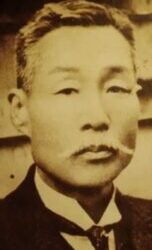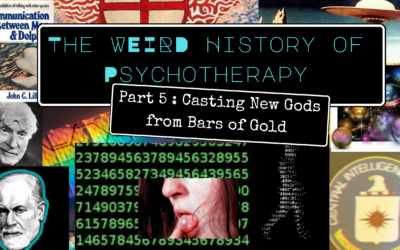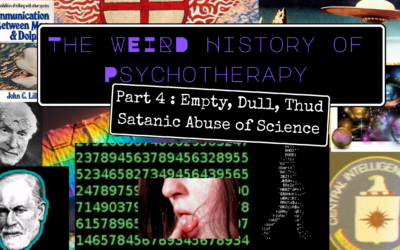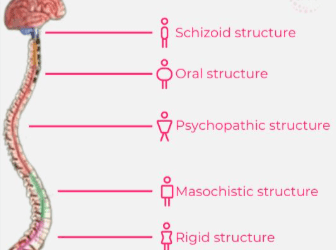
The Gesstalt Field
The Rise, Fall and Rebirth of Gestalt Therapy: Fritz Perls’ Legacy and Post-Jungian Integration
Gestalt therapy, with its focus on the “here and now” of experience and its innovative, experiential techniques, has had a profound impact on the field of psychotherapy. Founded by the enigmatic psychiatrist Fritz Perls, Gestalt therapy flourished in the 1960s as part of the humanistic psychology movement. However, it later fell out of academic favor, only to reemerge in recent decades, integrated with post-Jungian approaches such as Voice Dialogue, Process-Oriented Psychology, and Internal Family Systems (IFS) therapy. This article examines the history of Gestalt therapy, from its beginnings to its current manifestations, exploring the reasons behind its initial decline and subsequent revival.
The Origins of Gestalt Therapy: Fritz Perls’ Vision
Gestalt therapy was founded by German-born psychiatrist Friedrich “Fritz” Perls (1893-1970), along with his wife Laura Perls (1905-1990) and collaborator Paul Goodman (1911-1972). Fritz Perls, initially trained in psychoanalysis, grew dissatisfied with what he perceived as the constraints and inflexibility of Freudian theory and practice. Influenced by ideas from existentialism, phenomenology, Gestalt psychology, and Eastern philosophy, Perls developed a new approach emphasizing present-moment awareness, personal responsibility, and the wholeness of experience.
Key concepts in Gestalt therapy include:
Field Theory:
The idea that an individual can only be understood within the context of their dynamic, interconnected field, which includes both internal experiences and the external environment.
Figure and Ground:
Adapted from Gestalt psychology, this concept describes how certain experiences emerge into the foreground of awareness (figure) while others recede into the background (ground).
Contact and Boundary:
Gestalt therapy explores how individuals make contact with their environment and with disowned aspects of themselves, and the boundaries (both healthy and unhealthy) that govern this contact.
Paradoxical Theory of Change:
The belief that change occurs not by trying to be something one is not, but by fully embracing one’s present experience.
In his 1942 book Ego, Hunger and Aggression, Perls introduced the concept of “dental aggression”—the notion that an individual’s first attempts to healthily engage with and assimilate their environment appear during the oral stage of development, when the infant starts biting and chewing. Although this early theory was later expanded and refined, it established Perls’ focus on the role of aggression (not as hostility, but as the energy required for contact and growth) in personality development.
The Division between East and West Coast Gestalt
As Gestalt therapy gained popularity in the 1950s and 1960s, a philosophical and stylistic divide emerged between East Coast and West Coast practitioners.
The East Coast approach, centered around the New York Institute for Gestalt Therapy (founded by Fritz and Laura Perls in 1952), tended to emphasize theoretical rigor, intellectual analysis, and a more classical Gestalt therapy style. Key figures in this tradition included Isadore From, Paul Goodman, and Richard Kitzler.
In contrast, the West Coast approach, which coalesced around Perls’ work at Esalen Institute in California starting in the 1960s, was characterized by a more experiential, “in the moment” focus, often incorporating elements of Eastern spirituality and the human potential movement. Prominent West Coast Gestalt therapists included James Simkin, Miriam Polster, and Erving Polster.
While these two “schools” shared the core principles of Gestalt therapy, their differences in emphasis and style reflected the diverse influences shaping the approach as it evolved.
The Techniques and Practice of Gestalt Therapy
Gestalt therapy is renowned for its experiential techniques, designed to heighten awareness, intensify experience, and foster integration. Key techniques include:
- The Empty Chair: In this role-playing exercise, the client engages in dialogue with an imagined other (a person, a part of the self, or an abstract concept) represented by an empty chair.
- Exaggeration and Amplification: The client is encouraged to exaggerate or amplify a particular gesture, expression, or feeling to bring it more fully into awareness.
- Staying with the Feeling: The therapist asks the client to focus on and stay with a particular sensation or emotion, rather than trying to avoid or change it.
- “I Take Responsibility For…”: This technique encourages clients to own their projections and take responsibility for their feelings and experiences.
- Dream Work: Rather than interpreting dreams symbolically as in psychoanalysis, Gestalt therapy invites the client to re-enter and explore the dream as if it were happening in the present moment.
These techniques embody Gestalt therapy’s commitment to present-centered awareness, experimentation, and the integration of polarities within the personality. By engaging in these exercises, clients learn to accept and integrate disowned parts of themselves, take responsibility for their choices and actions, and develop more authentic and fulfilling ways of being in the world.
The Academic Decline of Gestalt Therapy
Despite its popularity in the 1960s and 1970s, Gestalt therapy began to lose favor in academic and professional circles in the following decades. Several factors contributed to this decline:
- Lack of Empirical Research: Gestalt therapy’s emphasis on the subjective and the experiential did not easily lend itself to quantitative research, which was increasingly prioritized in psychology. As a result, it was often perceived as lacking scientific rigor and empirical support.
- Association with the Counterculture: Gestalt therapy’s popularity in the 1960s counterculture movement, and its association with practices like encounter groups and the human potential movement, led some to view it as trendy or frivolous.
- Perls’ Controversial Reputation: Fritz Perls’ confrontational style and dramatic flair appealed to some but alienated others in the professional community. His emphasis on “shortcuts” and rapid change was viewed by some as superficial or lacking depth.
- Rise of Cognitive-Behavioral Therapies: The 1970s and 1980s saw the ascendance of cognitive-behavioral therapies, which offered a more structured, goal-oriented, and empirically validated approach that appealed to many in the field.
Due to these factors, Gestalt therapy became increasingly marginalized in mainstream psychology, often dismissed as a product of the “touchy-feely” 1960s. However, as we will see, many of its core principles and techniques would later be rediscovered and integrated into new approaches.
Insecurity and Skepticism within the Profession
Fritz Perls’ charismatic personality and unconventional methods often attracted skepticism and criticism from more traditional psychotherapists and psychoanalysts. Perls’ use of exaggeration, amplification, and dramatization to help patients identify and work with their emotions was sometimes seen as mere showmanship, lacking the intellectual rigor and theoretical depth of psychoanalysis.
However, Perls insisted that his techniques were grounded in a deep understanding of human psychology and were highly effective in facilitating rapid change and growth. He argued that by fully experiencing and expressing their emotions in the “here and now,” patients could break free from the neurotic patterns and “unfinished business” that kept them stuck.
Despite the effectiveness of Gestalt techniques, the psychotherapy profession has often been slow to embrace methods that seem to offer “shortcuts” to healing. Newer therapies like Brainspotting, EMDR (Eye Movement Desensitization and Reprocessing), [Lifespan Integration.
- Thomas, S. (2014). Emotional Transformation Therapy: An interactive ecological psychotherapy. W. W. Norton & Company.
- Clarkson, P. (2013). Gestalt counselling in action. SAGE.
- Woldt, A. L., & Toman, S. M. (2005). Gestalt therapy: History, theory, and practice. SAGE.
- Melnick, J., & March Nevis, S. (2013). Mending the world: Social healing interventions by gestalt practitioners worldwide. Gestalt Press.
- Wheeler, G. (2013). Beyond individualism: Toward a new understanding of self, relationship, and experience. Routledge.
- Mann, D. (Ed.). (2010). Gestalt therapy: Practice and theory. Routledge.
- Levine, T. B. Y., Leven, S. J., & Coyne, L. (2016). Gestalt therapy: Advances in theory and practice. Routledge.
Further Reading
For those interested in exploring Gestalt therapy and its related approaches in more depth, the following resources offer a wealth of information:
- The Gestalt Journal, a peer-reviewed scholarly journal dedicated to advancing Gestalt theory and practice.
- The Gestalt Review, a quarterly journal published by the Gestalt International Study Center, featuring articles, interviews, and book reviews related to Gestalt therapy.
- The Handbook of Gestalt Therapy, edited by Leslie Greenberg, Neil Holtz, Gordon Wheeler, and Robert Elliott, offering a comprehensive overview of the theory, research, and practice of Gestalt therapy.
- Gestalt Therapy: Excitement and Growth in the Human Personality, the seminal 1951 book by Fritz Perls, Ralph Hefferline, and Paul Goodman that first introduced Gestalt therapy to a wider audience.
- Gestalt Therapy Verbatim, a collection of transcripts from Fritz Perls’ sessions and workshops, offering a vivid demonstration of his style and techniques.
These resources, along with the works cited in the bibliography, provide a rich and varied perspective on the history, theory, and practice of Gestalt therapy, as well as its ongoing evolution and integration with other approaches.
Hashtags
#GestaltTherapy #FritzPerls #ExperientialPsychotherapy #HumanisticPsychology #EmptyChair #PresentCenteredAwareness #ContactBoundary #VoiceDialogue #ProcessOrientedPsychology #InternalFamilySystems #JungianPsychology #IntegrativePsychotherapy #Brainspotting #EMDR #LifespanIntegration #EmotionalTransformationTherapy
Meta Description
This in-depth article explores the rich history of Gestalt therapy, from its inception by Fritz Perls to its decline in academia and subsequent rebirth in post-Jungian integrative approaches. Learn about the key principles, techniques, and controversies of this influential experiential psychotherapy, as well as its lasting impact on contemporary methods like Brainspotting, EMDR, Lifespan Integration, and ETT.
](https://lifespanintegration.com/), and ETT (Emotional Transformation Therapy) have faced similar skepticism, despite growing evidence of their efficacy.
This resistance may stem in part from an insecurity within the profession, a fear that embracing these newer, more rapid methods could undermine the perceived value and expertise of traditional psychotherapy. There may also be a belief that treatments that work quickly cannot be as thorough or transformative as longer-term, insight-oriented therapies.
However, the enduring influence of Gestalt therapy and the growing acceptance of newer experiential therapies suggest that the field is gradually becoming more open to innovative approaches that prioritize experiential learning, present-centered awareness, and rapid change. As the evidence base for these methods continues to grow, it is likely that they will become more fully integrated into mainstream psychotherapy.
The Resurgence of Gestalt in Post-Jungian Approaches
In recent decades, there has been a renewed interest in Gestalt therapy, particularly within integrative, post-Jungian approaches that seek to bridge the gap between depth psychology and experiential techniques. Notable examples include:
- Voice Dialogue: Created by Hal and Sidra Stone, Voice Dialogue is a method for exploring and integrating the various subpersonalities or “selves” within the psyche. Like Gestalt therapy, it uses role-playing and dialogue to facilitate awareness and integration.
- Process-Oriented Psychology: Developed by Arnold Mindell, a former Jungian analyst, Process-Oriented Psychology (also known as Process Work) integrates Jungian concepts with Gestalt techniques, focusing on the “dreaming process” that underlies both individual and collective experiences.
- Internal Family Systems (IFS): Created by Richard Schwartz, IFS is a therapy that views the mind as a system of distinct subpersonalities or “parts.” Like Gestalt therapy, it emphasizes present-moment awareness, experiential techniques, and the integration of polarities within the self.
These approaches, and others like them, have sparked a renewed appreciation for the insights and techniques of Gestalt therapy, while integrating them with the depth and archetypal perspectives of Jungian psychology. They represent a move beyond the limitations of both the overly intellectual “talking cure” model of classical analysis and the sometimes superficial “feel-good” approach of 1960s-style Gestalt therapy.
The Enduring Legacy of Gestalt Therapy
Despite its fluctuating reputation within professional psychology, Gestalt therapy has left an indelible mark on the field, and its influence continues to be felt across a range of contemporary approaches. Its emphasis on present-centered awareness, experiential techniques, and the integration of mind, body, and environment has been incorporated into cognitive-behavioral therapies, somatic psychotherapies, and mindfulness-based interventions.
The resurgence of Gestalt principles in post-Jungian approaches like Voice Dialogue, Process-Oriented Psychology, and Internal Family Systems therapy demonstrates the enduring relevance of Gestalt therapy’s core insights. By integrating these insights with the depth and breadth of Jungian psychology, these approaches offer a promising path forward for a psychotherapy that is both experiential and archetypal, grounded in the present moment and attuned to the timeless patterns of the psyche.
As the field of psychotherapy continues to evolve, it is likely that we will see further iterations and integrations of Gestalt principles, as therapists and researchers seek to develop approaches that are effective, holistic, and responsive to the needs of contemporary clients. The legacy of Fritz Perls and Gestalt therapy, despite the controversies and criticisms, remains a vital part of this ongoing evolution.
For more information on supplemens for mental health consult our comprehensive guide for micronutrient and supplement therapy and how it can treat specific issues and enhance certain modalities of therapy.
If you’re interested in exploring micronutrient therapy as part of your anxiety treatment plan, Hardy Nutritionals offers a range of products to fit your specific needs. Their Daily Essential Nutrients clinical strength formula provides comprehensive, research-backed dosages in convenient capsule or powder form.
For 15% off in savings, use the offer code “Taproot” at checkout on the Hardy Nutritionals website to receive 15% off your order. @ GetHardy.com
It’s important to remember that while micronutrient therapy can be a powerful tool for managing anxiety, it is not a replacement for professional mental health care. Always consult with a qualified healthcare provider before starting any new supplement regimen, particularly if you have pre-existing health conditions or are taking medications.
Disclaimer: These statements have not been evaluated by the Food and Drug Administration. These products are not intended to diagnose, treat, cure, or prevent any disease. Please consult with a qualified healthcare professional before beginning any supplement regimen, particularly if you are pregnant, nursing, have a medical condition, or are taking medications. The information on this website doesnot constitute medical advice. We recieve a small commision on sales with Hardy Nutritionals through our offer code. Our affiliation does not effect treatment or recomendations made by Taproot authors, therapists or other staff.
Bibliography
- Perls, F. S. (1947). Ego, hunger and aggression. South African Medical Journal.
- Perls, F., Hefferline, R., & Goodman, P. (1951). Gestalt therapy: Excitement and growth in the human personality. Julian Press.
- Yontef, G. M. (1993). Awareness, dialogue & process: Essays on gestalt therapy. The Gestalt Journal Press.
- Crocker, S. (1999). A well-lived life: Essays in gestalt therapy. GICPress.
- Joyce, P., & Sills, C. (2018). Skills in gestalt counselling & psychotherapy. SAGE.
- Mann, D. (2010). Gestalt therapy: 100 key points and techniques. Routledge.
- Ginger, S. (2007). Gestalt therapy: The art of contact. Karnac Books.
- Bowman, C. E., & Nevis, E. C. (2005). Supporting gestalt therapy. Gestalt Press.
- Sommers-Flanagan, J. (2012). Counseling and psychotherapy theories in context and practice. John Wiley & Sons.
- Corey, G. (2016). Theory and practice of counseling and psychotherapy. Cengage Learning.
- Grand, D. (2013). Brainspotting: The revolutionary new therapy for rapid and effective change. Sounds True.
- Shapiro, F. (2017). Eye movement desensitization and reprocessing (EMDR) therapy: Basic principles, protocols, and procedures. Guilford Press.
- Pace, P. (2017). Lifespan integration: Connecting ego states through time. Lifespan Integration

























0 Comments